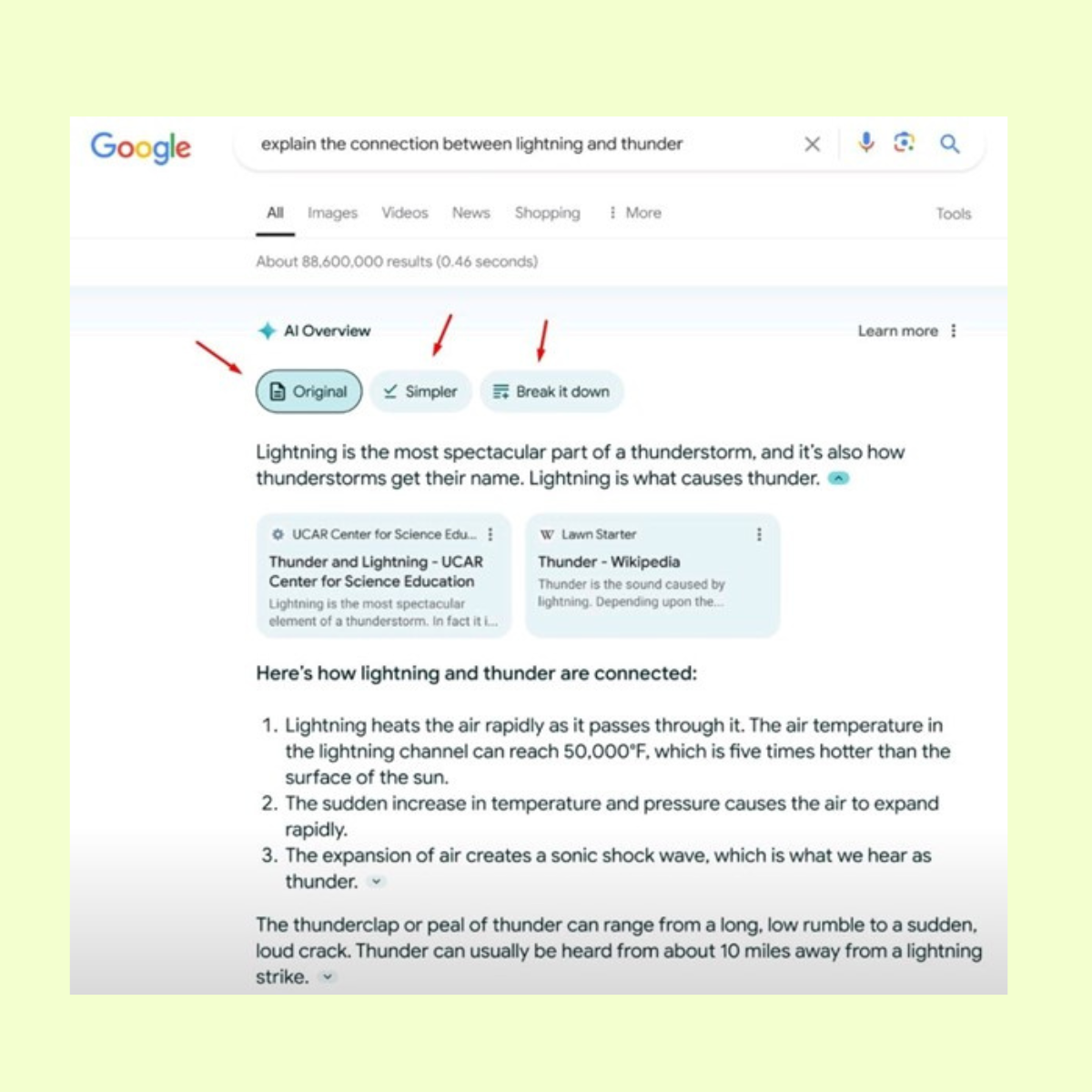
Google AI Overviews are here: What does this mean for businesses?
The long-awaited Google announcement regarding its AI search offering came via Google’s annual I/O event on May 14. The key takeaway from a search engine perspective was the official rollout of AI Overviews to search results in the US by the week commencing May 20, with the feature launching in the UK and other markets during August.
Google AI Overviews are what were previously known as SGE (Search Generative Experience) where AI-generated overview results, powered by Google’s Gemini AI, overlay in the search results for certain queries. The industry has been aware of this following last year’s I/O event, and there has been a lot of testing, research, and no shortage of opinion on it since.
Now that this is officially here, what does this mean for users and how can businesses optimise their sites for it?
Google AI Overviews: The user experience
As we mentioned, AI Overviews were ushered in in the form of SGE at the last Google I/O event in May 2023. Until now, the feature was available only to select users via opting into Google Search Labs, with some users being given the experience in the wild in March this year.
The feature gave users quick AI overview answers which occupied the top spot of search results above traditional search results. The overviews showed links to resources supporting this information and allow users to explore the topic further.
From Google’s Vice President, Head of Search, Liz Reid’s official blog post following the release on May 14, here’s a look at what it looks like in a variety of search formats in an accompanying promotional YouTube video:
The blog post also featured a specific long-tail informational query on the topic of lightning and thunder, resulting in this:

As you can see, a large chunk of the above-the-fold search result real estate is taken up by these AI Overview-generated answers where users have the option to view different formats in terms of how the information is presented to them. Google is framing this as them “taking care of the legwork” when it comes to planning and brainstorming certain topics.
This may apply to informational queries such as the above, or ideas for planning holidays or meal plans, to name a couple of examples, where Google pulls in information from the web to present the user with an overview.
Going further, the below GIF from Search Engine Land depicts the wider experience (on mobile) on the term “how do you clean a fabric sofa” an informational term, that brands in the cleaning industry may consider targeting as part of their top-of-funnel buyer journey:

Here, we can see a detailed, step-by-step AI Overview with source attributions, followed by paid search ads, People Also Ask results, and then below this, traditional organic results. For terms such as these, the user is presented with a wide array of options to explore their query further and pursue their purchase journey.
In addition, Google has also announced additional upgrades to its AI-powered search experience such as built-in planning capabilities, visual search querying and adjustable overviews (as shown in the thunder and lightning example).
It’s important to note that at this stage, AI Overviews will only appear for limited queries. A recent study by Search Engine Land also showed that search results with AI Overviews appeared to decline from May onwards, which may suggest that Google is opting for a more cautious rollout of this feature currently.
What does this mean for businesses?
Ever since Google announced AI Overviews at its I/O event in May 2023, there have been plenty of opinions and speculation as to the ramifications of this new era of search when it comes to businesses and their SEO efforts.
Google has said that AI Overviews, with their associated link cards to relevant resources, will develop higher click-through rates than traditional web searches and is touting AI Overviews as a way to enhance search quality. Despite this, however, the AI Overviews occupying large areas of search result real estate may limit organic and PPC click-through rates on traditional search results as they are pushed further down the fold.
While AI Overviews won’t appear for every type of search query, businesses will want to aspire to be featured in them as resource links and should consider tailoring aspects of their SEO strategies to achieve this.
In terms of e-commerce businesses specifically, we took a look at what this may mean in a post last year, with brands encouraged to focus on their structured data efforts and PDP optimisation in order to compete.
How to optimise for AI Overviews
While we are still in the early stages of exploration and learning when it comes to Google AI Overviews, there are a number of things businesses can consider when optimising to appear for them.
On the day of the I/O event, Google updated their AI Overview documentation with some insights on how Google generates AI Overviews. While there isn’t any specific information (yet) on how to appear in these overviews, Google mentions the Knowledge Graph as a key source of information among other sources across the web, implying that E-EAT and overall reputation will play a strong role in determining this. The documentation also references the relevance of its Google Search Essentials for webmasters to keep in mind when it comes to SEO, implying that nothing has changed here.
Interestingly, Google’s documentation does provide guidance on how brands can prevent their content from appearing in AI Overviews, chiefly by deploying the nosnippet metatag.
Beyond what Google is saying, there are some clues we can glean in terms of the nature of AI Overview content in relation to certain queries and what may trigger these.
Content structure and readability
From what has been exhibited, we can see that AI Overviews are attempting to answer queries in a straightforward question-and-answer format. Taking the above thunder and lightning example, we can see that surfaced answers are high up the readability scale in terms of straightforward, concise sentences that answer the question. Improving the readability of your content in terms of its structure and layout and applying question and answer type format (where relevant) is advised.
Target long-tail search queries
User search behaviour has evolved far beyond the traditional two to three-word searches. While succinct search terms do still occur, search behaviour has become a lot more conversational and more specific in style as users look for answers to particular needs. AI Overviews are attempting to solve these, and brands should look to optimise for answers to these long-tail type queries in their content.
Analyse the search results
There aren’t any keyword research tools on the market for AI Overviews (yet), and there is currently no way to track AI Overview numbers in Google Search Console. However thorough analysis of what results are being triggered in terms of AI Overviews for certain queries is advised. For a long-tail informational query like “How long does it take to become proficient in French” what types of answers and sources are being surfaced by AI? This can give businesses a strong indicator as to what Google is opting for.
Structured data
Structured data provides AI models with additional information about your content, brand and products. Particularly when it comes to e-commerce SEO, product markup on information such as price, review and availability can aid your brand when it comes to appearing in AI searches for commercial queries.
Enhance your E-EAT credentials
Brand authority and trustworthiness is something Google has been pushing for some time, and resource links and citations from AI Overviews will largely lean on publications that are known experts in their field. In addition, getting your brand or business featured on third-party sites or directory sites relevant to your industry is worthwhile. Taking tech as an example, AI Overviews will often present answers from sources such as PCMag or TechRadar when users are searching for queries such as “antivirus software providers”. This is currently represented in existing search result features such as rich snippets.
Prioritise technical SEO and site crawlability
Google’s AI models will, like Googlebot, crawl website content to surface results in its AI Overviews. Businesses should continue to prioritise technical SEO ventures, that being to ensure your website has clear and coherent site architecture, is fast, and is easily navigable for both users and search engines.
Thinking ahead
There has inevitably been a lot of noise, conjecture and speculation over what AI Overviews will mean for the future of search. Given that SGE/AI Overviews have been in the wild for over a year now, there are some studies and insights that carry merit, some of which we’ve detailed above that can be taken away to form strategies moving forward. Alongside this, SEO fundamentals in terms of solid technical foundations and first-in-class content will remain vital, if not more important than before.
It’s clear that AI Overviews are here to stay, and this means for some search queries traditional search results will look very different. As AI Overviews are introduced across the world, businesses will need to keep a keen eye on the visibility of queries that trigger AI Overview results, observe patterns and optimise accordingly.
About the author
Senior SEO Consultant Luke Gosha joined Reddico in December 2020 after working for five years within the insurance industry. In his past role, he oversaw acquisition marketing and developed an in-house SEO team. Luke is now responsible for leading client accounts, from managing communications to identifying areas of improvement. Luke recently made his first appearance at brightonSEO, taking to the stage to talk about how leadership skills can be leveraged to work with AI.
Read more News & Insights >
Sign-up to Reddico News
To keep up-to-date with the latest developments in the world of SEO, our insights, industry case studies and company news, sign-up here.




